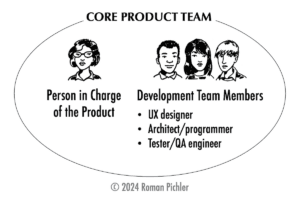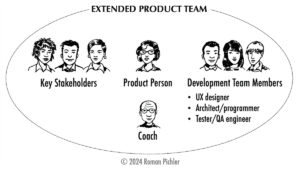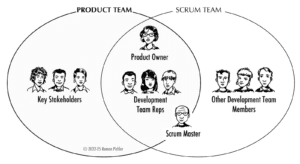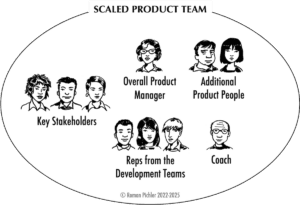Product teams play a crucial part in achieving product success. But who should be on the team? How can the group become high-performing? Who is the boss on the team? And what is the difference between a product team and a Scrum team? These are some of the questions on product teams that I am frequently asked, and that I answer in this article.
What are product teams and why are they important?
A product team is a group of people who collaborate effectively, have ownership of a product, and are responsible for achieving product success. This means in practice that product teams carry out product discovery and guide delivery; some are also responsible for product strategy.
Product teams are important, as product management is a team sport. It is very difficult for a product manager to make all decisions by themselves, even if they are very experienced, due to the breadth of knowledge required. Additionally, product people rely on others to help them progress their products. This includes UX designers, developers, and testers, as well as marketers, sales reps, and customer support team members who design, build, market, sell, and support the product.
You can find more information in the article Building High-Performing Product Teams.
Who should be in a product team?
Product teams benefit from having the person in charge of the product/the product manager, a UX designer (for end-user-facing product), an architect/programmer, and a tester/QA engineer as team members, as Figure 1 shows. This group is also referred to as the core product team.
If a product team is responsible for product strategy, in addition to product discovery and delivery, it is advisable to form an extended team and include key stakeholders, as shown in Figure 2. A key stakeholder is someone who has an interest in the product and whose expertise and support are required to make effective decisions and progress the product. This might be might a marketer, sales rep, and customer support team member, depending on the product type and organisation.
Having stakeholders on the product team can offer the following benefits:
- Better decisions using the stakeholders’ expertise.
- Improved clarity and alignment.
- Stronger stakeholder buy-in to key decisions.
- Higher autonomy and faster decision making.
As the extended product team in Figure 2 is comparatively large and diverse, I recommend adding a coach as a team member. The individual helps the team members work together effectively. This includes facilitating meetings, addressing conflicts, and helping the team reach agreements.
You can find more information in the articles Building High-Performing Product Teams, Should Stakeholders Be on the Product Team?, and Strategy and Product Teams.
What should you consider when forming a product team?
Research shows that team design has the biggest impact on its performance. To put it differently, if a team has not been set up properly, it will struggle to do well. Apply the following recommendations will help you effectively design a product team:
- Clarify the team’s purpose, goals, and level of empowerment. For example, is the team responsible for product strategy, product discovery, and delivery?
- Identify necessary roles and skills and fill them with the right people. For instance, do you need a UX designer? Should the key stakeholders be on the team? Would the team benefit from having a coach?
- Ensure organisational support and sponsorship. For example, who is the management sponsor?
- Provide the right tools and working environment. For instance, does the team need a team room?
When staffing a product team, aim for stability and long-term membership. The team members should understand that they are likely to work on the team for an extended period—months and years, rather than days and weeks.
Additionally, form a product team early on in the product life cycle, if possible. Ideally, the team should be assembled in time to carry out the initial product strategy discovery work. It should continue to exist until the product is discontinued. This fosters long-term thinking and allows the team members to develop a deep understanding of the market and user needs, the competitive landscape, and the underlying business model.
You can find more information in the article Setting up Product Teams for Success.
What actions help a product team become high-performing?
- Involve the right people, use clear roles, and build trust early.
- Give the team the empowerment and organisational support it needs.
- Help the team set clear goals using, for example, my goal-setting framework and Strategy Stack, and hold it collectively accountable for outcomes.
- Keep the team stable over time. Minimise changes to avoid handoffs and loss of knowledge.
- Hold regular, collaborative workshops.
- Foster psychological safety and encourage continuous learning.
- Give the team a coach who helps the members work together effectively. This includes facilitating meetings, resolving conflicts, and helping the team members reach agreements.
You can find more information in the articles Building High-Performing Product Teams, and Setting up Product Teams for Success.
Who is the boss on a product team?
There is no boss or supervisor on a product team. Instead, it is as a group of peers with a flat organisational structure: No team member reports to another member.
Additionally, the team should be self-managing, also referred to as self-organising. Its members are therefore collectively responsible for identifying and executing tasks, as well as monitoring and managing their work. Consequently, there is no team lead or manager who assigns and tracks tasks.
Leadership on a self-managing team is shared. For example, the person in charge of the product leads product decisions; the UX designer leads the discovery and design of the right user experience; a sales rep might lead the creation of an effective sales strategy; and a team coach leads the effort to help the team self-manage and improve their ways of working.
The benefits of a self-managing product team include:
- Reduced workload/cost savings: The product manager does not have to act as a team lead but can focus on maximising the value the product creates. Not having to use a dedicated project manager reduces cost.
- Better decisions and improved innovation: Involving all product team members in important decisions can lead to better outcomes.
- Increased adaptability: Not relying on a single person to identify and monitor the work leads to increased agility and reduces the risk of having to wait for a decision from the top.
- Higher motivation and productivity: Owning the work improves motivation and can lead to higher productivity.
Despite it’s been promoted especially in an agile context for more than two decades, self-management is still a comparatively new approach for many organisations. What’s more, it usually does not happen on its own but needs to be encouraged and supported. To effectively practise self-management, teams usually require a skilled coach who guides them and helps the members acquire the right skills, like collaborative decision-making and conflict resolution.
How often should the product team members meet?
What meetings a product team should have and how often they should take place depends on the team’s responsibilities. For a product team responsible for product strategy, product discovery, and product delivery, I recommend scheduling the following joint sessions:
- Product strategy workshop, 2-4 hours, once every three months: Review and update the product strategy and product roadmap.
- Sprint review or similar, 2-4 hours, once per month: Understand the progress made, offer feedback on latest product increment/prototype.
Note that the list above states regular, collaborative meetings. It does not imply that strategy work does not need to be carried out more frequently or that sprint reviews should not be held more often.
What is the difference between a product team and a Scrum team?
A Scrum team consists of a product owner, a Scrum Master, and several developers, who are also known as the development team. The team is responsible for creating value in each sprint and is tasked to carry out all product-related activities, including UX research and design, software architecture development, programming, testing, as well as stakeholder collaboration.
Despite their similarities, a Scrum team is not identical to a product team. While the former focuses on creating value in a sprint, the latter is responsible for achieving product success. This includes developing the right product strategy and ensuring that an effective business model is available. Additionally, a Scrum team does not contain any stakeholders, unlike an extended product team.
When forming a product team in Scrum, the person in charge of the product, the product owner, development team representatives, and the Scrum Master join the team, as Figure 3 illustrates.
As Figure 3 shows, the product owner, Scrum Master, and development team representatives are part of two teams, the product team and the Scrum team.
You can find more information in the article Product Teams in Scrum.
How do product teams change on large products/in a scaled environment?
For products that are so large that they cannot be managed by a single product manager, the product team should be enlarged. It should now include the product manager, the key stakeholders, representatives from the development teams, as well as the additional product people required to manage the product, as Figure 4 shows.
Aim to limit the number of product team members to about 12 to avoid slow decision making and high communication cost. If that’s not possible, explore if the product can be split, for example, by unbundling one or more features and treating them as a separate product.
What are common mistakes when using product teams?
- The product team is not organised around a product. Instead, it might be looking after a product part like an end-user-facing feature, or it might be a project team.
- The team lacks empowerment and support. The members don’t have the authority to make the necessary decisions, they don’t have the right equipment and tools, and they may not have the right management sponsor.
- The team members lack skills and/or availability. The individuals therefore struggle to do a good job and achieve the agreed outcomes.
- The team is not stable. Team members frequently join the team and leave after a short period.
- The team lacks a coach. Conflicts aren’t resolved, decision-making is slow, and the team struggles to manage its work. The product manager has to moderate meetings and act as a team lead/project manager rather than being able to focus on their actual job.





Post a Comment or Ask a Question